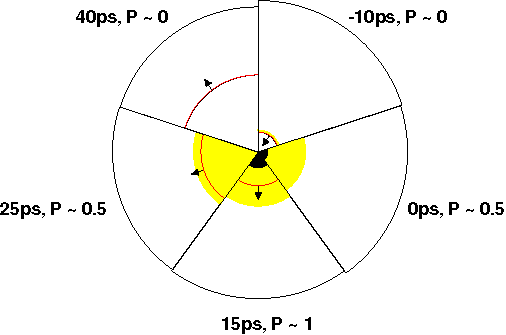
Figure 1. The final 50 ps of the calculated collapse of an argon bubble. The bubble radius (outermost curve), shock wave location (inner curve), and emitting regions [optically thin (shaded), and optically thick (solid)] are shown. P is the relative emitted power (energy per unit time) of light in the visible part of the spectrum.
The figure shows our calculated results for a collapsing argon bubble. Five snapshots of the final 50 ps of the collapse are shown, during which the radius of the bubble decreases from 0.45 to 0.43 microns. Time is referenced to the instant when the shock wave reaches the center of the bubble.
At -10 ps, the shock wave (solid curve) is near the center of the bubble and light begins to be emitted (lightly shaded region) just behind the shock wave. At 0 ps, the shock reaches the center of the bubble. At this point, the power (energy per unit time) that is emitted in the visible spectrum is one-half its eventual peak value.
The emitting regions of the bubble are very much like those in a miniature star: Visible light from the sun appears yellow, which is indicative of a temperature of approximately 6000K. However, the center of the sun is much hotter, nearly 107 K.
This temperature can't be "seen," because the light that is emitted from the deeper regions is absorbed before it reaches the surface. This deeper absorbing region is described as being "optically thick." The solid black region in the figure shows where the bubble is optically thick. Only the light emission from the "halo" (lightly shaded region) and from the surface of the optically thick region can be seen. At 15 ps, the shock has reflected from the center of the bubble and is moving outward, but the gas outside the shock is still moving towards that bubble's center, compressing, and heating. Consequently, the emitting halo is slightly larger and the emitted visible optical power is at its peak value.
At 25 ps, the light emitting halo is even larger, but the bubble has cooled, so that the emitted visible optical power has decreased to one-half its peak value. At 40 ps, the bubble is too cool to emit light. The bubble temperature decreases for two reasons. First, the gas behind the outgoing shock wave expands and cools. Second, electrons carry away some of the heat that was created during the compression of the bubble. By comparing the times at which one-half peak power occurs, a 25 ps pulse width can be deduced from the figure, which is consistent with the experimentally measured value.
Our model agrees with many experimental results: (i) the durations of the light flashes and the spectra that they produce are very sensitive to the maximum bubble radius; (ii) the spectrum of the emitted light is described by the radiative properties of the hot gas, especially the radiation from decelerating electrons; (iii) the intensity of the emitted light from nitrogen SBSL is approximately 1/25 of that from air SBSL; and (iv) the spectrum of argon SBSL is nearly identical to the measured spectrum of air SBSL, which suggests that a sonoluminescing air bubble is actually an argon bubble undergoing SL [2], and may also explain why SBSL in noble gases (such as argon) is more intense than in diatomic gases (such as the nitrogen or oxygen that exists in our atmosphere). Our model suggests that the mechanisms that are responsible for the ultrashort (picosecond) duration of SBSL are the electrons rapidly carrying away the energy from the bubble and the very strong temperature dependence of the emission properties of the compressed gas. Our model predicts that after the main flash there cannot be an "afterglow" emitted by the expanding hot bubble.
The physics of matter under SL conditions is not yet understood completely. Our results suggest that our basic theoretical and computational strategy is valid, and that semiquantitative predictions are possible. For example, if the collapse of the bubble can be enhanced, thereby raising the bubble temperature even higher, then it may be possible to obtain a small amount of thermonuclear fusion from a micron-sized sonoluminescing bubble filled with heavy isotopes of hydrogen (deuterium or tritium). Although it remains to be confirmed experimentally that shock waves or plasmas are present in a bubble undergoing SL, no other model of which we are aware has been able to explain such a broad array of experimental data.
This work was performed under the auspices of the U. S. Department of Energy by Lawrence Livermore National Laboratory under Contract No. W-7405-Eng-48.
References
[1] D. F. Gaitan et al., J. Acoust. Soc. Am. 91, 3166 (1992).
[2] D. Lohse et al., Phys. Rev. Lett. 78, 1359 (1997).
[3] B. P. Barber and S. J. Putterman, Nature 352, 318 (1991).
[4] W. C. Moss, D. B. Clarke, and D. A. Young, Science 276,
1398 (1997).